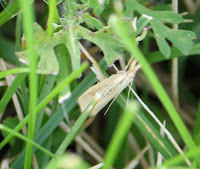 |
| The handsome Lark Sparrow |
Two developments over the past year changed my laissez-faire attitude toward sparrows. First was seeing a charming little sparrow on the Greenway last May, hopping up from the pavement to grab beaksful of dandelion seeds. Its strikingly-patterned face--bold black stripes over a white face, with a rufous patch over the ear--was different enough that even I could easily match it to that of the Lark Sparrow in my guide. So not all sparrows were nondescript!
 |
| Lincoln's Sparrow |
 |
| Swamp Sparrow |
I am making a point to photograph sparrows with as much zeal as I do the flashier birds I encounter, and attempting to put names to their faces. I still have an unfortunate tendency to assume all sparrows are those I am familiar with, and trying to force them into names that don't quite fit ("gosh, that one looks a little like an American Tree Sparrow, but the beak isn't right...and something is a little off...." "That's because it's a Swamp Sparrow, you goof," says iNaturalist*). But I'm working on it!
Sparrows are an interesting group of birds, worthy of attention in their own right even if they prove to be challenging. Different species can be seen in our area throughout the year, each with their own life histories and niches to learn about. And there are only around 20 species commonly seen in our area...how hard can it be?**
*Dramatization, may not have happened exactly as described. These online forums are consistently helpful and friendly to anyone trying to learn.
**It's pretty hard. But worth the effort!
















































